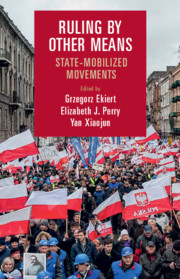Book contents
- Ruling by Other Means
- Cambridge Studies in Contentious Politics
- Ruling by Other Means
- Copyright page
- Contents
- Figures
- Tables
- Contributors
- Acknowledgments
- 1 State-Mobilized Movements: A Research Agenda
- 2 Manufactured Ambiguity
- 3 Suppressing Students in the People’s Republic of China
- 4 State-Mobilized Community Development
- 5 Enforcement Networks and Racial Contention in Civil Rights–Era Mississippi
- 6 Social Sources of Counterrevolution
- 7 Occupy Youth!
- 8 State-Mobilized Movements after Annexation of Crimea
- 9 Mirroring Opposition Threats
- 10 Mobilizing against Change
- 11 The Dynamics of State-Mobilized Movements
- 12 State-Mobilized Campaign and the Prodemocracy Movement in Hong Kong, 2013–2015
- 13 The Resurrection of Lei Feng
- Index
- Books in the Series (continued from p.iii)
- References
9 - Mirroring Opposition Threats
The Logic of State Mobilization in Bolivarian Venezuela
Published online by Cambridge University Press: 29 July 2020
- Ruling by Other Means
- Cambridge Studies in Contentious Politics
- Ruling by Other Means
- Copyright page
- Contents
- Figures
- Tables
- Contributors
- Acknowledgments
- 1 State-Mobilized Movements: A Research Agenda
- 2 Manufactured Ambiguity
- 3 Suppressing Students in the People’s Republic of China
- 4 State-Mobilized Community Development
- 5 Enforcement Networks and Racial Contention in Civil Rights–Era Mississippi
- 6 Social Sources of Counterrevolution
- 7 Occupy Youth!
- 8 State-Mobilized Movements after Annexation of Crimea
- 9 Mirroring Opposition Threats
- 10 Mobilizing against Change
- 11 The Dynamics of State-Mobilized Movements
- 12 State-Mobilized Campaign and the Prodemocracy Movement in Hong Kong, 2013–2015
- 13 The Resurrection of Lei Feng
- Index
- Books in the Series (continued from p.iii)
- References
Summary
Hugo Chávez and his Bolivarian Movement came to power in 1999 promising to refound the Venezuelan state and restructure the polity in ways that would build “popular power” through the promotion of grassroots participation, organization, and mobilization. Once in office, the Bolivarian forces launched a series of initiatives to sponsor organization and mobilization among supporters, which ranged widely in their functions and strategic purpose. State-mobilized organizations can be seen as operating in three different arenas of politics: the local governance arena; the electoral arena; and the protest arena. From an ideological standpoint, the Bolivarian Movement was oriented toward sponsoring organizations that could operate in the first of these arenas, helping realize Chávez’s vision of constructing a “protagonistic democracy” by establishing vehicles for citizen participation in local governance. In the terminology of this volume, these activities are best seen as a form of “infrastructural mobilization,” working to solidify political support and achieve the government’s longer-term aims.
- Type
- Chapter
- Information
- Ruling by Other MeansState-Mobilized Movements, pp. 217 - 238Publisher: Cambridge University PressPrint publication year: 2020
References
- 2
- Cited by



